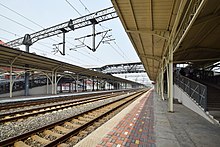The Tianjin–Pukou or Jinpu railway (Postal spelling: Tientsin-Pukow Railway; simplified Chinese:

You can help expand this article with text translated from the corresponding article in Chinese. (January 2020) Click [show] for important translation instructions.
|
History
editThe first proposals to build railways in China began in the 1860s with opposition from the elite, who worried that it would increase the likelihood of regime change. However, following China's loss in the First Sino-Japanese War in 1895, the desire to modernize began to predominate. However, due to technical and financial constraints, foreign support was needed to build the earliest railways. At a conference in London in September 1898, British and German capitalists decided to build a railway from Tianjin to Zhenjiang. In May 1899, the Qing government agreed to the financing of the railway construction along with a series of bank loans. The proposed course for the railway was to connect the political center of China in the north to the economic hub in the southern region, as well as the Yangtze River. Construction of the railway began in 1908 and the line was completed in 1912.[2] All together, the original railway line was built with 85 stations, of which 31 were in Shandong province.
Rail traffic had to be ferried across the Yangtze to Nanjing to connect with the railroads passing through that city until the Nanjing Yangtze River Bridge was built across the river in 1968. Currently, it is the main section of Beijing–Shanghai railway.
References
edit- ^ Manchurian railways and the opening of China : an international history. Bruce A. Elleman, Stephen Kotkin. Armonk, N.Y.: M.E. Sharpe. 2010. ISBN 978-0-7656-2516-8. OCLC 676700653.
{{cite book}}: CS1 maint: others (link) - ^ Mahltig, Philipp (December 2019). ""German railways" in China: Technology as a site of knowledge". The Journal of Transport History. 40 (3): 301–321. doi:10.1177/0022526619868564. ISSN 0022-5266. S2CID 211414201.
See also
edit